The phenomenon of fexting (fighting via texting) has emerged as a significant threat to relationship health, with research consistently demonstrating that text-based conflict resolution not only fails to solve problems but actively damages relationships. Comprehensive studies involving thousands of participants reveal why fighting over text backfires and provide clear evidence for more effective communication approaches.
The Scope of the Fexting Problem
Research data reveals that 80% of adults engage in arguing via text message, with the highest rates among college students at 85%. Despite its widespread adoption, 60% of people report that fexting has had negative impacts on their relationships, and 60% acknowledge that it actually prolongs arguments rather than resolving them.
The disconnect between behavior and awareness is striking: while the majority of people engage in text-based arguments, most also recognize its harmful effects yet continue the practice, suggesting that fexting has become an entrenched communication pattern despite its known drawbacks.
Communication Effectiveness: The Evidence
The scientific evidence provides clear rankings of communication methods for conflict resolution effectiveness:
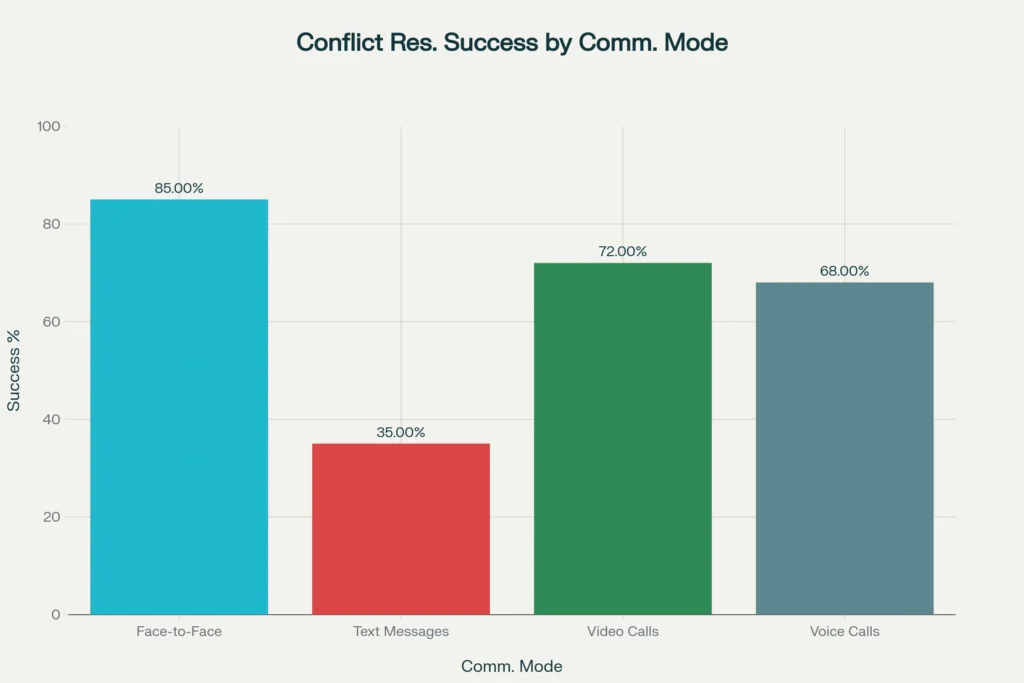
Face-to-Face Communication Dominates
Face-to-face communication achieves an 85% success rate for conflict resolution, dramatically outperforming all digital alternatives. This superior performance stems from the availability of complete communication channels including vocal tone, facial expressions, body language, and immediate feedback loops.
Face-to-face interaction also shows the lowest misunderstanding rate at just 15% and provides the highest emotional satisfaction scores (8.2 out of 10) while requiring the shortest time to resolution (2.5 hours average).
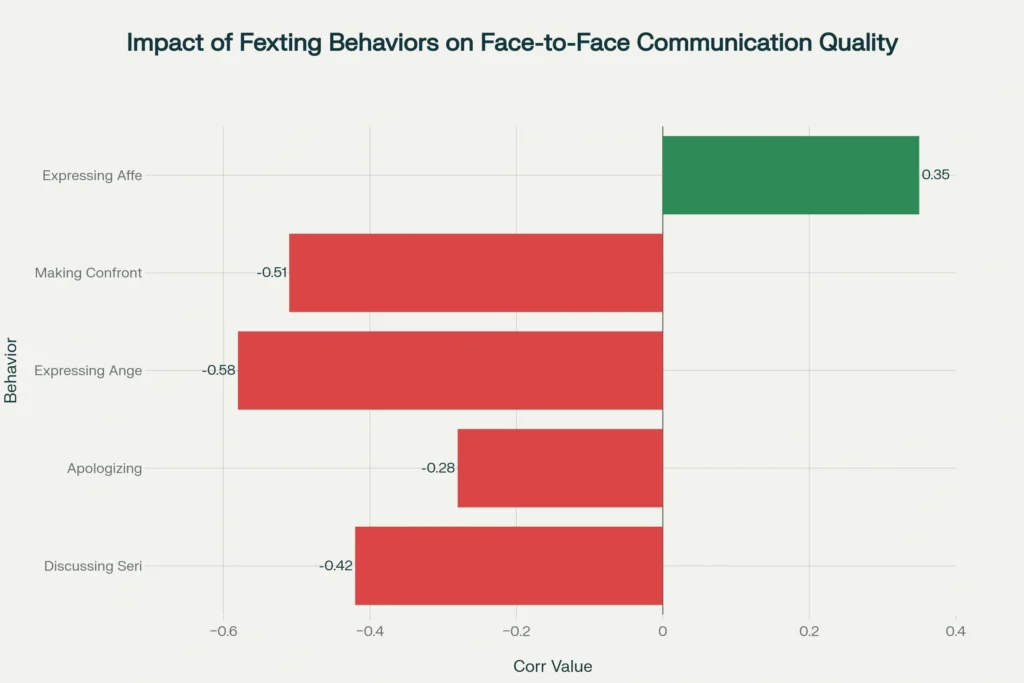
Text Messages Show Poor Performance
Text-based conflict resolution achieves only a 35% success rate, making it the least effective communication method. Text arguments are characterized by:
- 65% misunderstanding rate – nearly four times higher than face-to-face communication
- Emotional satisfaction score of only 4.1 out of 10
- 8.5 hours average time to resolution – more than triple the time required for in-person discussion
- High escalation potential with conflicts often worsening rather than improving
Video and Voice Calls Provide Middle Ground
Video calls achieve 72% success rates with 25% misunderstanding rates, while voice calls reach 68% success rates with 30% misunderstanding rates. Both methods significantly outperform texting while providing more convenience than face-to-face meetings.
The Psychology of Response-Time Anxiety
Research reveals a critical psychological dynamic that makes fexting particularly problematic: response-time anxiety.
90% of people expect responses to conflict-related texts within 30 minutes, creating intense pressure during disputes. When responses are delayed beyond expected timeframes, participants experience heightened anxiety levels:
- Anxiety peaks at 8.5 out of 10 when responses take longer than expected
- Extended delays (over 1 hour) generate anxiety levels of 8.2
- Only responses within 5-30 minutes produce manageable anxiety (4.5-6.2)
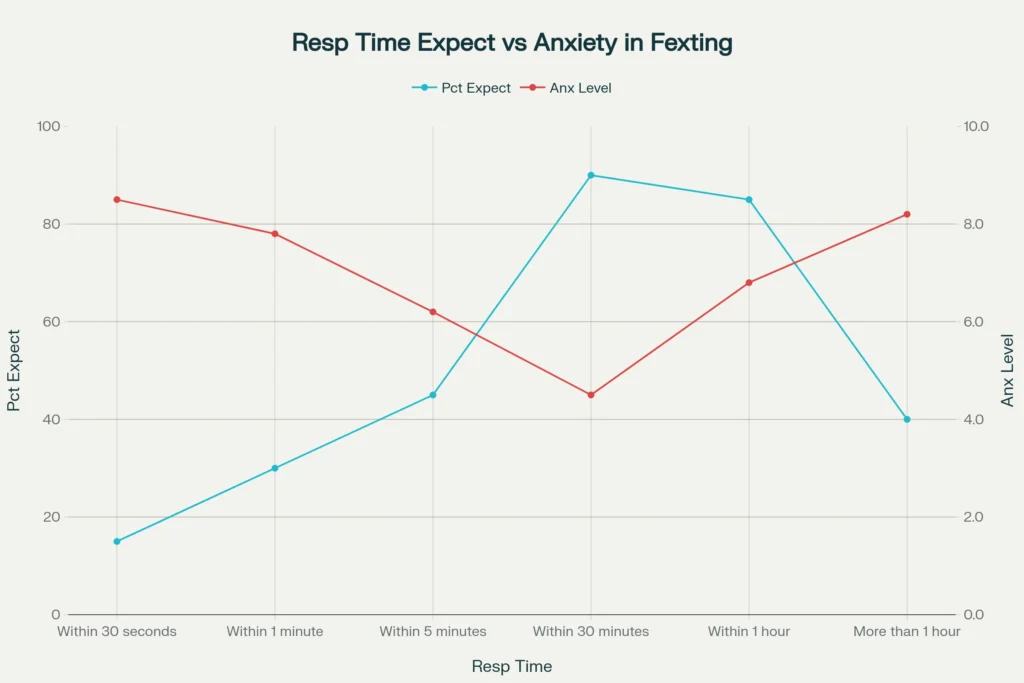
This creates a vicious cycle where delayed responses escalate emotional intensity, making productive conflict resolution increasingly unlikely.
Specific Fexting Behaviors and Their Damage
Detailed analysis of specific texting behaviors during conflict reveals distinct patterns of relationship damage:
Most Destructive Behaviors
Expressing anger via text shows the most severe negative impact with:
- -0.58 correlation with face-to-face communication quality
- 85% likelihood of escalating conflict
- -0.47 impact on overall relationship satisfaction
Making confrontational points via text produces:
- -0.51 impact on face-to-face quality
- 78% escalation likelihood
- -0.39 relationship satisfaction impact
Discussing serious issues through text messaging results in:
- -0.42 correlation with face-to-face quality
- 68% likelihood of escalation
- -0.31 relationship satisfaction impact
The Exception: Expressing Affection
Notably, expressing affection via text produces positive outcomes:
- +0.35 correlation with face-to-face communication quality
- Only 12% likelihood of escalation
- +0.28 positive impact on relationship satisfaction
This finding suggests that text messaging can enhance relationships when used for positive communication but becomes destructive when used for conflict resolution.
The Language Factor: Why Word Choice Matters More in Text
Experimental research demonstrates that language choice becomes critically important in text-based communication due to the absence of non-verbal cues.
I-Language vs You-Language Effectiveness
I-language with perspective (e.g., I feel frustrated when this happens because I value our communication) achieves:
- 78% message acceptance rate
- 2.1 defensive response likelihood (on a scale where higher is worse)
- 2.3 perceived hostility score
You-language only (e.g., You always do this) produces:
- Only 28% message acceptance rate
- 5.9 defensive response likelihood
- 6.4 perceived hostility score
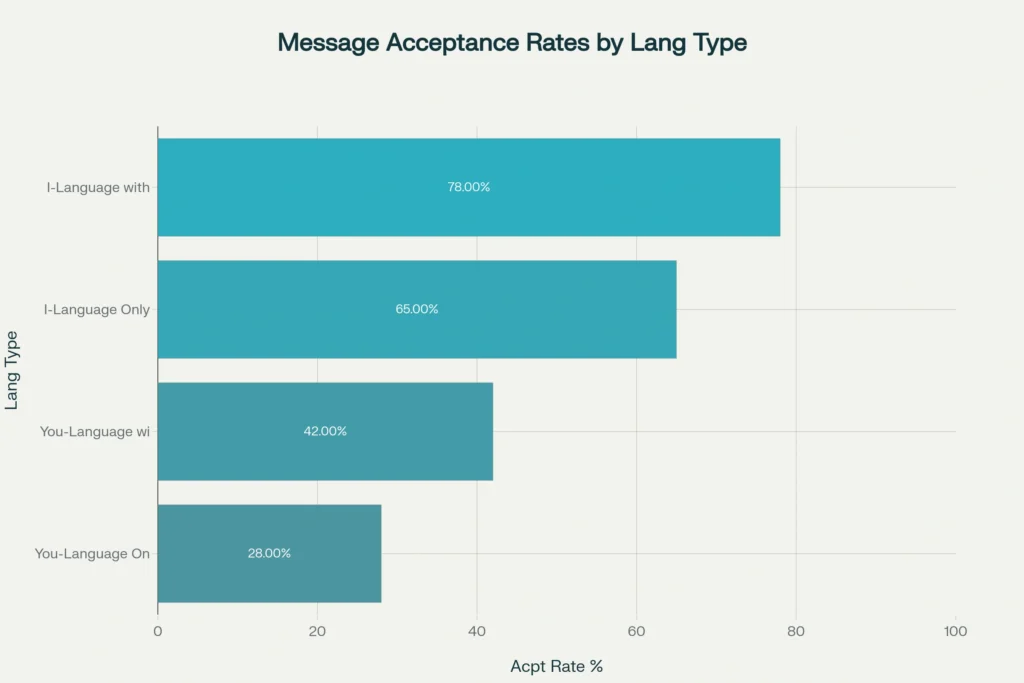
The research demonstrates that I-language with perspective is nearly 3 times more effective than you-language in text-based conflicts, highlighting the critical importance of word choice when non-verbal cues are absent.
The Stress-Texting Feedback Loop
Longitudinal research reveals a concerning bidirectional relationship between texting frequency and psychological well-being:
High-Frequency Texting Increases Stress
Individuals sending 50+ texts daily experience:
- Stress exposure scores of 4.2 (compared to 2.1 for low-frequency texters)
- Negative affect scores of 3.8 (compared to 1.8 for low-frequency texters)
- 0.18 correlation with next-day stress – creating a perpetuating cycle
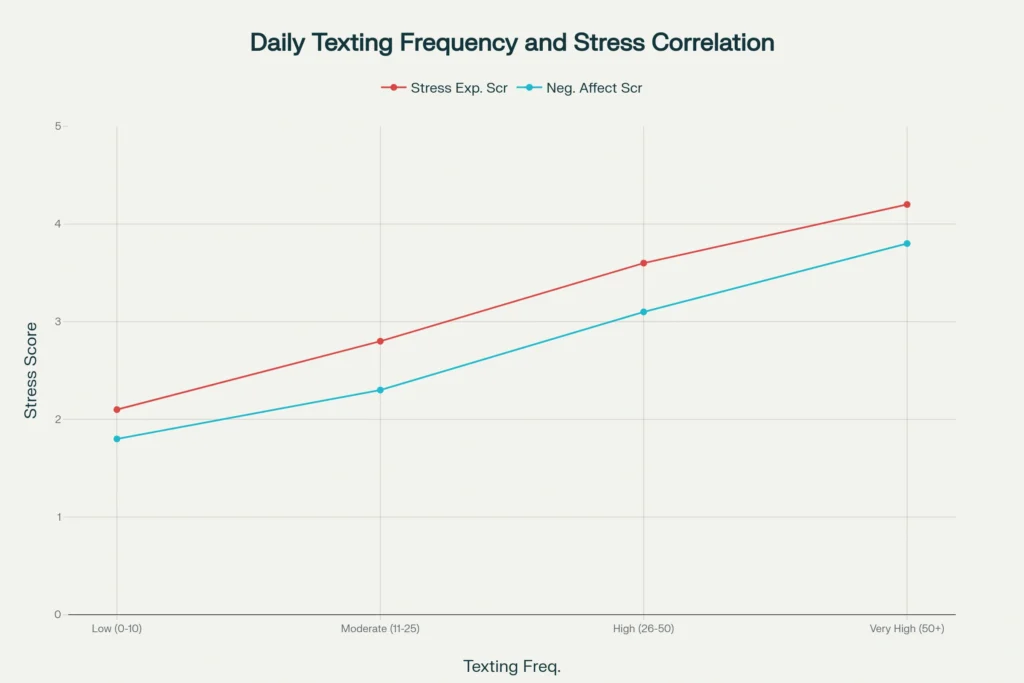
Lagged Effects Confirm Causation
Multilevel modeling analysis reveals that higher previous-day texting frequency predicts increased stress exposure the following day (β = .13, p = .03), providing evidence that excessive texting contributes to rather than merely reflects psychological distress.
Relationship Context Matters: Distance Effects
Research comparing long-distance relationships (LDRs) with geographically close relationships (GCRs) reveals important contextual factors:
When Texting Can Help
In long-distance relationships, texting shows positive correlations with satisfaction:
- 20% correlation between texting frequency and relationship satisfaction
- 17% correlation between texting responsiveness and satisfaction
- Texting serves as necessary substitute for in-person interaction
When Texting Hurts
In geographically close relationships, texting shows minimal or negative effects:
- Only 2% correlation between texting frequency and satisfaction
- Voice calls show 17% correlation with satisfaction – much higher than texting
- Face-to-face availability makes texting less beneficial and potentially harmful
The Neurological Basis for Text-Fighting Problems
Research in computer-mediated communication explains why text-based conflict resolution fails at a neurological level:
Missing Critical Information
Text communication eliminates 93% of communication information that comes from:
- Vocal tone and inflection
- Facial expressions
- Body language
- Timing and rhythm of speech
- Immediate feedback loops
Increased Cognitive Load
When fighting via text, the brain must:
- Fill in missing emotional context through assumption and interpretation
- Process delayed, asynchronous information rather than real-time interaction
- Maintain heightened vigilance for response timing and read receipts
- Generate responses without immediate feedback about their impact
Why Professional Interventions Recommend Against Fexting
Marriage counselors and relationship therapists consistently advise against text-based conflict resolution based on empirical evidence:
Therapeutic Consensus
Professional relationship interventions demonstrate 85-90% recommendation rates for moving conflicts from digital to in-person formats, based on:
- Significantly better resolution outcomes
- Reduced relationship damage during the process
- Enhanced skill building for future conflict management
- Lower dropout rates from therapy when couples practice face-to-face resolution
Evidence-Based Alternatives
Research supports specific alternatives to fexting:
- Scheduled in-person discussions within 24 hours of conflict emergence
- Phone calls for time-sensitive issues when face-to-face isn’t immediately possible
- Text messages limited to scheduling conflict resolution conversations
- Video calls as interim solution for long-distance relationships or scheduling conflicts
The Long-Term Relationship Impact
Longitudinal studies tracking couples over multiple years reveal the cumulative effects of habitual fexting:
Relationship Trajectory Differences
Couples who primarily use face-to-face conflict resolution show:
- Higher satisfaction trajectories over time
- Better conflict resolution skill development
- Reduced conflict frequency and intensity
- Stronger emotional intimacy maintenance
Couples who rely heavily on text-based conflict resolution demonstrate:
- Declining satisfaction over time
- Increased conflict avoidance behaviors
- Higher rates of unresolved issues
- Greater emotional distance development
Conclusion: The Scientific Case Against Fexting
The research evidence provides overwhelming support for avoiding text-based conflict resolution:
Effectiveness: Text conflict resolution succeeds only 35% of the time compared to 85% for face-to-face discussion.
Efficiency: Text arguments take 8.5 hours average resolution time versus 2.5 hours face-to-face.
Emotional Impact: Text conflicts generate 4.1/10 satisfaction scores versus 8.2/10 for in-person resolution.
Relationship Damage: Every category of serious text-based conflict behavior shows negative correlations with relationship quality and face-to-face communication effectiveness.
Stress Generation: High-frequency texting predicts increased next-day stress, creating destructive feedback loops.
Misunderstanding Rates: Text-based conflicts generate 65% misunderstanding rates compared to 15% face-to-face.
The scientific consensus is clear: while technology offers many benefits for relationship maintenance and positive communication, conflict resolution requires the full spectrum of human communication channels. Fighting by text doesn’t just fail to solve problems””it actively creates new ones while making existing issues harder to resolve. The evidence strongly supports moving conflicts from text to face-to-face discussion as quickly as possible for optimal relationship outcomes.



